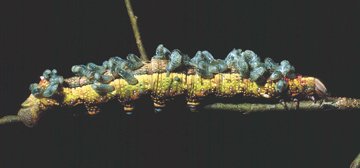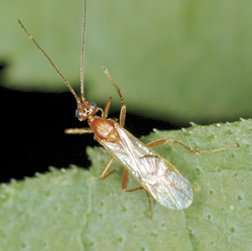Poisonous Partnership
Parasitoid wasps use viruses as a weapon
The attack of a small black wasp doesn’t seem to faze the caterpillar that’s munching on the leaf of a maple tree—at least not at first. After getting stung, the caterpillar continues to crawl around and eat as if nothing happened. But 10 days later, it suddenly slows its crawl. It stops eating and eventually stops moving but remains attached to a branch. The dozens of eggs that the wasp injected into the caterpillar have hatched, and the wasp larvae are now eating their host alive. By the time the larvae burst out through the caterpillar’s skin, there is little else left of their victim.


The wasp responsible for this gory scene is called a parasitoid rather than a parasite. The distinction is that parasitoids kill their hosts, whereas parasites usually don’t. Parasitoid wasps aren’t familiar to most people because the creatures tend to be small and they lack the flashy stripes of their better-known wasp and bee cousins. But scientists estimate that there are hundreds of thousands of parasitoid wasp species, more than all the species of ants, bees, and nonparasitoid wasps put together.
Entomologists have been studying parasitoid wasps since the 1800s, and farmers have used them for decades to fight crop-destroying caterpillars. But in the 1970s, scientists made a remarkable discovery. They learned that many parasitoid wasp species inject viruslike particles, along with the wasp eggs, into caterpillars. The toxicity of the virus particles devastates the caterpillar’s immune system and prevents it from destroying the eggs into caterpillars. Without the virus, the wasp’s eggs wouldn’t survive.
Despite their dramatic effect in the caterpillar, these viruses, in a family called polydnaviruses, can’t replicate there. New copies of the virus particles are made only inside a wasp’s ovaries, where the virus apparently causes no harm. The polydnavirus is therefore entirely dependent on the wasp for replication, and vice versa.
The dependence of the wasp and the polydnavirus on one another is a rare, perhaps unique, example of a symbiotic relationship between a virus and an animal. This relationship is so close that the virus’ DNA has become part of the wasp’s genome and is inherited by each new wasp generation.
Polydnaviruses are “extremely unusual,” says Dawn Gunderson-Rindal, who studies polydnaviruses at the Beltsville Agricultural Research Service in Maryland. “Some people don’t even think they are viruses.”
Scientists have recently discovered that the relationship between wasp and polydnavirus is extremely ancient. What’s more, the first sequence of DNA from one of these viruses shows that it has undergone a dramatic transformation as a result of its association with the wasps and, in its modern form, is unlike any other virus known.
Ancient origins
Scientists suspect that at least two different viruses independently developed symbiotic relationships with parasitoid wasps. Today, the polydnaviruses associated with each wasp family, the braconids and the ichneumonoids, look quite different.
James B. Whitfield of the University of Illinois at Urbana-Champaign has found evidence that in the braconid wasp family, at least, the advent of the symbiotic relationship dates to ancient times. Whitfield made the assumption that today’s braconid wasps all descended from a single ancestor that somehow acquired the virus. Then, he studied the DNA of the modern wasps to determine when this ancestor lived.
Whitfield’s genetic analysis, published in 2002, indicates that the wasp that picked up the founding virus lived around 65 million to 75 million years ago, when dinosaurs roamed Earth.
So far, no one has completed a comparable analysis for the ichneumonoid family, so it isn’t clear when it acquired its symbiotic virus.
Researchers have also been studying polydnaviruses’ DNA. It has turned out to be very unusual. The typical virus reproduces by entering a host cell, making abundant copies of itself with materials supplied by the host, and then bursting out of the cell. Each copy that emerges contains all the genes needed to make more viruses, including the genes that make the viral shell, or capsule.
Unlike most viruses, however, the polydnavirus particles that go from wasp to caterpillar don’t carry all the genes for a capsule. Some of the capsule genes, although they presumably originally came from a virus, today reside instead in the wasp’s genome. Therefore, polydnaviruses are incapable of replicating in a caterpillar or anywhere else outside their host wasps.
The virus particles injected by the wasps into caterpillars appear to have only two actions—to take down the insect’s immune system and to prevent the caterpillar from metamorphosing.
This much had been known since the early 1990s, but many questions remained. What was the ancestor virus like before it took up residence in wasps? How did it fit in among known ancient virus families? How has the virus changed since then?
To address such questions, Jean-Michel Drezen of the National Center for Scientific Research in Tours, France, and his team recently sequenced the genetic material that encodes the virus particles found in one species of braconid wasps. The results, published in the Oct. 8, 2004 Science, were not at all what Drezen and his team expected.
Previous studies had suggested that the virus particles were very simple, containing just a handful of genes coding for a handful of proteins. “We thought that there were maybe on the order of three, four, five proteins produced by these viruses,” says Drezen. “But we found an enormous number of genes . . . more than 150 potential genes. It’s a lot more complex than we first thought.”
The researchers were also surprised by how little the polydnavirus has in common with other viruses. Like many other researchers, Drezen had thought that the symbiotic viruses found in the braconid wasps were probably related to baculoviruses, which are common in insects and have capsules shaped like those of the symbiotic viruses. But the researchers found little similarity between polydnavirus DNA and that of baculovirus or any other virus.
Drezen’s team already knew, from others’ work, that polydnavirus DNA comes in paired strands, which is unusual for a virus but the norm for cellular organisms. Drezen says that he suspects that the DNA now packaged inside polydnavirus particles didn’t originate in the ancestor virus at all but probably came from the braconid wasps.
Gene swapping between the virus and the wasp seems to have dramatically changed the virus. Not only has its structural genes been taken over by the wasp genome, but it has also seemingly gained wasp DNA.
Decoding the polydnavirus’ DNA has provided a wealth of information about the contents of the virus capsules, but it’s done little to pin down the virus’ relationship with other virus families. Perhaps when scientists have sequenced the wasp genome, the viral genes there will show similarities to those of other viruses.
Virus or a wasp organ?
The bizarre characteristics of the polydnavirus have triggered debate over whether, in its modern form, it’s a virus at all. Brian A. Federici of the University of California, Riverside likens it to a wasp-cell organelle, such as a mitochondrion, but one that gets secreted.
“It is totally integrated and never really free to replicate on its own,” he says.
Most researchers agree that mitochondria are descendants of a formerly free-living bacterium that somehow got inside a cell, where it struck up a symbiotic relationship. Over time, genes that once resided in the mitochondria got transferred to cells’ genomes. Federici says that the new evidence from Drezen’s team reinforces the view that something similar happened with polydnaviruses.
The scenario of viral DNA getting stuck in a host’s genome and being inherited by later generations of the host organism may not be unusual. “There’s evidence in the human genome of tons of retrovirus-infection events, and they’re part of our genome now,” says Don B. Stoltz, who studies polydnaviruses at Dalhousie University in Nova Scotia.
Some scientists have estimated that as much as 1 percent of the human genome is leftover viral DNA. One of the most-studied of these viral genes in people encodes a protein called syncytin. There is some evidence that this protein plays a role in the normal fusing of a layer of cells in the placenta (SN: 5/13/00, p. 318: Available to subscribers at Placental Puzzle).
Pesticide potential
The United States, Canada, and the European Union are all funding studies of polydnaviruses because they may become powerful weapons against caterpillars that eat farmers’ crops or grubs that damage trees. “I’ve heard the effect of polydnaviruses in insects described as ‘insect AIDS,'” says Gunderson-Rindal. “And that’s what it is. It’s a shutdown of the immune system so that the insect is not going to survive.”
Although parasitoid wasps kill caterpillars in the wild, their numbers often aren’t sufficient to keep crop pests under control. To protect their plants, farmers sometimes raise and release the wasps, but researchers are looking into simpler, less-expensive ways of taking advantage of polydnaviruses’ pest-control potential.
At the University of Kentucky in Lexington, Bruce A. Webb and his colleagues have created a company to develop pest-control agents from polydnaviruses. It has obtained several patents related to this approach. Webb and his colleagues are developing genetically modified crops that include polydnavirus genes, which could make the plants toxic to the caterpillars that eat them.
“The genes that are now in polydnaviruses have gone through 50 or 60 million years of selection for virulence traits,” says Webb. “We’re looking at those genes to see which ones work best.”
Mysterious ancestor
Many labs are now trying to sequence the genes of polydnaviruses other than the one that Drezen and his colleagues studied. Although smaller than most organisms’, polydnavirus genomes are difficult to analyze.
Obtaining sufficient quantities of the virus particles is challenging, since they don’t form outside the wasp. Also, polydnaviruses’ DNA has multiple copies of some genes, sometimes on the same strand of DNA and sometimes on multiple strands. Those repeated genes complicate the sequencing.
Drezen and other polydnavirus researchers are also sequencing the genomes of the wasps to get at the virus genes that have lodged there and are no longer included in the virus particles. The researchers’ aim is to reveal more details about the ancestors of polydnaviruses and to explain how these unusual organisms are related to other viruses.
That, in turn, should provide clues to the circumstances leading to the strange relationship between the polydnavirus and the wasp and to whether similar circumstances elsewhere might have given rise to animal-virus partnerships that have yet to be discovered.